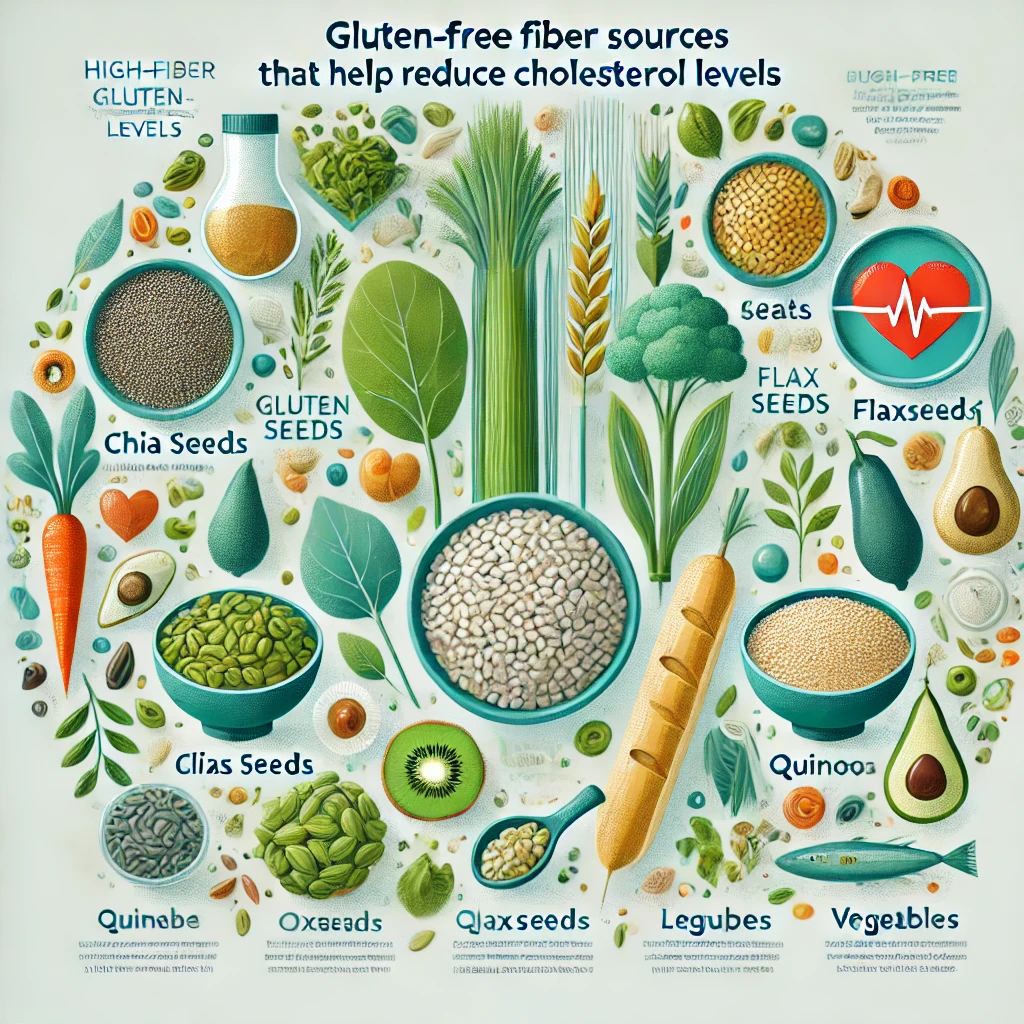Last Updated on September 13, 2025 by Irshad Quadri
Introduction
In today’s era of fast-food and processed food, cholesterol has become a major health concern. High cholesterol can be a major cause of heart disease, but there is a simple and natural solution – fiber! If you are following a gluten-free diet, you also have many healthy and fiber-rich options that can help lower cholesterol.
In this blog, we will explore 8 gluten-free fiber sources that help reduce cholesterol naturally. Also, we will learn natural ways to lower cholesterol with fiber, and how plant-based fiber is important for a healthy heart.

Fiber and Cholesterol Connection
Fiber comes in two types – soluble fiber and insoluble fiber. Both are beneficial for health, but soluble fiber is more effective in reducing cholesterol.
✅ Function of Soluble Fiber
- It binds with bile acids in the intestine, which slows cholesterol production.
- It helps eliminate LDL (bad cholesterol) from the bloodstream.
- It also controls blood sugar levels by slowing digestion.
✅ Function of Insoluble Fiber
- It improves digestion and keeps bowel movements smooth.
- It helps remove toxins and waste materials from the body.
Table of Contents
Best Gluten-Free Fiber Sources That Help Reduce Cholesterol
Now let’s talk about the best gluten-free fiber sources that can help reduce cholesterol.
1. Chia Seeds
Chia seeds are a superfood loaded with fiber and omega-3 fatty acids. They are a good source of soluble fiber that binds cholesterol and helps eliminate it from the body.
✅ How to consume?
You can make a pudding by soaking them in water or almond milk.
You can add them to smoothies and oatmeal.
2. Flaxseeds
Flaxseeds are also loaded with soluble fiber and lignans that are beneficial for heart health.
✅ How to consume?
Mix flaxseed powder into roti or paratha dough.
Sprinkle it in smoothies and curd.
3. Oats (Certified Gluten-Free)
Oats are one of the best soluble fiber (beta-glucan) source that helps in reducing LDL cholesterol naturally.
✅ How to consume?
You can make oatmeal for breakfast.
You can prepare homemade granola bars.
4. Quinoa
Quinoa is a high-fiber, gluten-free grain that helps in digestion and cholesterol control.
✅ How to consume?
You can make quinoa pulao or salad.
You can add it to soup and khichdi.
5. Legumes (Lentils, Chickpeas, Beans)
Legumes like lentils, kidney beans and chickpeas are rich in fiber and help in reducing LDL cholesterol.
✅ How to consume?
You can make lentil tadka or sprouts salad.
You can enjoy hummus or chickpea chaat.
6. Fruits & Vegetables (Avocado, Apples, Berries)
Fruits like apples, pears, oranges and berries are rich in soluble fiber and effectively control cholesterol.
✅ How to consume?
Use in fruit salads and smoothies.
Eat fresh fruits as a snack.
7. Nuts & Seeds (Almonds, Walnuts, Sunflower Seeds)
These nuts are loaded with healthy fats and fiber that improve heart health.
✅ How to Consume?
Eat roasted nuts as a snack.
Add nut butter or smoothies.
8. Psyllium Husk (Isabgol) for Fiber Boost
Psyllium husk is a highly concentrated fiber source that is very effective in lowering LDL cholesterol.
✅ How to Consume?
Eat with water or warm milk.
Mix in smoothies and flour.
How Fiber Lowers LDL Cholesterol?

Binds with cholesterol and eliminates it from the bloodstream.
Nourishes gut bacteria which improves digestion.
Fat absorption slows down, which keeps cholesterol levels balanced.
Case Studies & Scientific Backing
✅ Harvard Study
High-fiber diet can reduce LDL cholesterol by 5-10%.
✅ American Heart Association
Soluble fiber-rich foods improve heart health. Source
Infographic: High-Fiber Gluten-Free Foods Chart

How to Integrate These Foods into Your Diet?
Breakfast
Chia pudding or oatmeal
Flaxseed Smoothie
Freebie for you – If you are intersted in Gluten-Free 7 Day Meal Plan, fill in the below details and get your copy:
Lunch & Dinner
Quinoa salad
Lentil soup
Snacks
Nuts & berries
Roasted chana
Bonus 1: Fiber Supplements vs. Natural Foods – Which Is Better?
🥦 Section 1: Fiber Supplements vs. Natural Foods – Which Is Better?
Think of an anime battlefield ⚔️ — on one side is Fiber Supplements (heroes like Psyllium Husk, Metamucil), and on the other side is Natural Foods Army (Oats, Quinoa, Legumes, Fruits & Veggies). Both have their own power, but the question is — Which one is stronger in the fight against cholesterol?
🎭 Fiber Supplements – Quick Fix Heroes
Psyllium Husk (our desi Isabgol) is like an old-school anime master. It comes in simple, white powder form and when consumed with water, it forms a gel that binds LDL cholesterol and flushes it out of the body. Research also says that daily psyllium husk can reduce LDL cholesterol by 5–10%.
Branded supplements like Metamucil feel like a “ready-made energy capsule”. Easy to carry, easy to consume, and no complicated cooking is required.
👉 Pros:
- Super easy & quick — just a glass of water + husk.
- Travel-friendly.
- Effective in lowering cholesterol (especially LDL).
👉 Cons:
- Provides only fiber, missing extra nutrition.
- Overuse can cause bloating or constipation.
- If it becomes a long-term habit, natural food intake decreases.
🌱 Natural Foods – The True Anime Warriors
Now let’s talk about the real champions — Plant-based fiber for a healthy heart. Imagine a squad of oats, quinoa, legumes, flaxseeds, fruits, and veggies fighting together. These foods not only provide fiber, but also vitamins, antioxidants, omega-3 fatty acids and minerals.
- Oats (Certified Gluten-Free) → Beta-glucan fiber which actively reduces cholesterol.
- Quinoa & Legumes → Complex carbs + high protein, which slow down digestion and keep blood sugar stable.
- Avocado & Nuts → Healthy fats + fiber combo = reduces LDL, strengthens HDL.
👉 Pros:
- Full package (fiber + nutrients + antioxidants).
- Satiety increases, so overeating is controlled.
- Best fiber sources for lowering cholesterol in long-term.
👉 Cons:
- Takes a little planning and cooking time.
- Can be difficult during travel or busy routine.
⚖️ Supplements vs. Natural Foods – The Verdict
Think of it in an anime hero analogy — supplements are like a “special move” (instant), but natural foods are the main storyline power that always delivers long-term results.
If you are a busy office-going person, then Psyllium Husk in water is a quick fix. But if you want sustainable health, then an avocado toast, chickpea salad, or oats bowl is the best choice.
Another fact — studies show that natural fiber-rich foods not only lower LDL cholesterol but also improve gut microbiome, reduce inflammation, and reduce long-term heart disease risk.
💡 Practical Anime Tip
“Consider fiber supplements a ‘backup power’, but the real victory is when your diet includes oats, quinoa, legumes and nuts daily. Supplements = Sidekick, Natural Foods = Main Hero!” 🌟
So, next time when it comes to cholesterol, remember — natural ways to lower cholesterol with fiber are unbeatable. Supplements can be used occasionally, but Plant-based fiber for a healthy heart is the true anime hero squad you need. ❤️
Bonus 2: Lifestyle + Fiber: The Heart-Healthy Combo
🆕 Section 2: Lifestyle + Fiber: The Heart-Healthy Combo
Anime heroes always fight better when they have a strong team. Same goes for your health—fiber + lifestyle is the ultimate duo to defeat bad cholesterol (LDL) and protect your heart. It’s not just what you eat, it’s also how you win and how you move that matters. Let’s break it down anime-style.
Hydration & Fiber – Water is the Chakra Flow
Think Naruto without chakra—impossible, right? Similarly, fiber doesn’t work without water. The main job of fiber is to make digestion smooth and bind cholesterol and expel it. But if you don’t drink enough water, the fiber gets wasted and there is a risk of constipation. So whenever you follow natural ways to lower cholesterol with fiber, always include 2–3 liters of water. Fiber moves like chakra only when the water flow is strong.
Exercise & Fiber – Batman & Robin Teamwork
Imagine Batman fighting solo, it would be a bit of a struggle. But with Robin, teamwork doubles the impact. By the way, a fiber-rich diet works best when you move a little too. Walking, jogging, or yoga + high-fiber foods = faster LDL reduction. Studies also say how fiber lowers LDL cholesterol gets even stronger effect when combined with daily exercise. So next time you eat oats, quinoa or flaxseeds, take a brisk walk too. Fiber + movement = unbeatable tag team.
Stress & Fiber – Calm Like a Monk
In anime, monks or samurai are always calm, and that is their strength. Stress messes up digestion—acidity, bloating, and even gut imbalance. When you are stress-free, fiber-rich foods show their magic properly. Fiber helps build a healthy gut microbiome, which improves cholesterol metabolism. Meaning, stress is reduced, digestion is smooth, and cholesterol is in control. Think about it, fiber is your Zen master that calms the storm inside you.
Cooking Hacks – Easy Swaps, Big Wins
- White rice → Quinoa (more fiber, more protein)
- Chips → Roasted chickpeas (crunchy + fiber bomb)
- White bread → Multigrain or oat bread
- Sugary cereal → Overnight oats with nuts & seeds
These swaps do not require any extra effort, but cholesterol levels improve naturally. Basically, cooking hacks are like your anime “power-up.”
Wrap-Up: Lifestyle + Fiber = True Anime Squad
Fiber is a hero in itself, but without lifestyle support it cannot use its full power. Water, exercise, stress management, and smart cooking—these are all our sidekicks. Together, they form your ultimate anime squad to fight LDL cholesterol. Soch lo—fiber is Goku, lifestyle habits are his Super Saiyan transformations. Alone strong, but together unstoppable.
FAQs about Gluten-Free Fiber Sources for Lowering Cholesterol

Gluten-Free Fiber & Cholesterol FAQs
Gluten-free fiber refers to dietary fiber sources that do not contain gluten. Examples include fruits, vegetables, legumes, chia seeds, flaxseeds, and gluten-free oats.
Yes, soluble fiber binds to cholesterol in the digestive tract and helps remove it from the body, reducing LDL (bad) cholesterol levels.
Quinoa, buckwheat, millet, brown rice, and gluten-free oats are fiber-rich grains suitable for a gluten-free diet.
Adults should aim for 25–30 grams of fiber daily, with at least 5–10 grams from soluble fiber to effectively lower cholesterol.
They can be, since many gluten-free products are refined. Choosing whole gluten-free grains, legumes, fruits, and veggies ensures enough fiber intake.
Soluble fiber dissolves in water and lowers cholesterol, while insoluble fiber adds bulk to stool and aids digestion.
Yes, beans and lentils are rich in soluble fiber, which helps lower LDL cholesterol and supports heart health.
Yes, psyllium husk is naturally gluten-free and clinically proven to lower cholesterol by providing soluble fiber. (Research Link)
Yes, apples, pears, oranges, and berries are rich in soluble fiber (pectin) that reduces LDL cholesterol naturally.
Yes, fiber adds bulk, slows digestion, and keeps you full longer—helping with weight control and indirectly lowering cholesterol.
Yes, chia seeds, flaxseeds, almonds, and walnuts provide both fiber and heart-healthy fats.
Yes, soluble fiber helps lower triglycerides by improving blood sugar control and reducing fat storage.
Yes, gluten-free oats contain beta-glucan, a soluble fiber that lowers LDL cholesterol. (Research Link)
Yes, long-term studies show high fiber intake reduces the risk of cardiovascular disease by lowering LDL cholesterol and improving overall heart health.
The best fiber sources for lowering cholesterol include oats, barley, chia seeds, flaxseeds, legumes, and psyllium husk. These provide soluble fiber, which binds to cholesterol and helps flush it out of the body. (Research Link)
Soluble fiber forms a gel in the gut, trapping cholesterol and preventing its absorption into the bloodstream. This naturally reduces LDL cholesterol. (American Heart Association)
Yes, a high-fiber diet reduces triglycerides by improving insulin sensitivity and slowing down sugar absorption. This prevents fat build-up in the blood.
Natural ways include eating oats, barley, beans, lentils, chia seeds, flaxseeds, and fresh fruits like apples and pears. Pair with exercise and hydration for best results. (Healthline)
Yes, plant-based fiber helps reduce LDL cholesterol, improves digestion, and supports gut bacteria that lower inflammation—key for a healthy heart. 🌿
Fiber supplements like psyllium husk can help, but natural sources such as legumes, oats, and vegetables provide additional nutrients and antioxidants.
Cooking can slightly reduce fiber content, but most plant-based fiber remains intact. Steaming and light cooking preserve fiber better than boiling.
Yes, children can benefit from gluten-free fiber sources like fruits, vegetables, quinoa, and oats (gluten-free certified). It supports healthy digestion and growth.
Women need around 25g per day, while men should aim for 30–38g. Meeting this helps regulate cholesterol and maintain gut health.
Yes, soluble fiber slows sugar absorption, improving blood sugar control and reducing diabetes risk—beneficial for cholesterol management too.
Yes, soluble fiber helps reduce belly fat by increasing satiety, improving metabolism, and lowering cholesterol.
Excess fiber can cause bloating, constipation, and reduce absorption of some nutrients. Balance is key—gradually increase intake.
Apples, pears, oranges, and berries are excellent soluble fiber sources that help lower LDL cholesterol.
Most gluten-free breads are low in fiber unless fortified. Choose those made with whole grains like brown rice, quinoa, or buckwheat.
Eating fiber-rich foods while maintaining regular exercise strengthens heart health, lowers LDL cholesterol, and improves circulation.
Yes, probiotics and fiber act as a powerful duo. Fiber feeds healthy gut bacteria (prebiotic effect), improving digestion, lowering cholesterol, and boosting immunity.
Conclusion
If you want to naturally control cholesterol levels, start including these 8 glutenfree fiber sources that help reduce cholesterol levels in your diet! These fiber for cholesterol control foods are not only the best, they will improve heart health, but will also be beneficial for overall digestion and wellness. 💚
✅ FREEBIE: Download Gluten-Free Fiber Chart PDF
✅ Subscribe: Join our weekly health newsletter for more tips!
How did you like this blog? Do give your feedback in the comments! 😊
Affiliate Disclosure
This blog contains affiliate links, meaning I may earn a small commission if you purchase through these links, at no extra cost to you. I only recommend products I trust and believe will benefit my readers. Your support helps keep this site running—thank you! 🙌

About the Author
Irshad Quadri is a Health & Wellness blogger who simplifies topics like cholesterol management, weight loss, and heart health for everyday readers. On iq4u81.blog, he shares science-backed diet tips, easy recipes, and practical guides to help people live healthier — without losing the joy of food.
